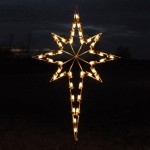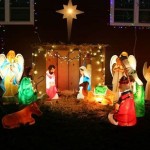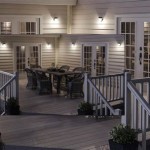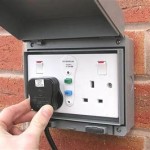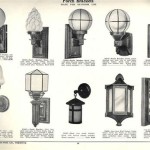```html
Ideas for Outdoor Lighting: Illuminating Your Landscape
Outdoor lighting serves multiple purposes, extending beyond mere illumination. It enhances safety and security, highlights architectural features, and creates an inviting ambiance for outdoor living spaces. Consider various factors, including the size of the property, existing landscape elements, and desired aesthetic, when planning an outdoor lighting scheme.
Effective outdoor lighting seamlessly blends functionality with design. Thoughtful placement, appropriate fixture selection, and strategic use of different lighting techniques are crucial for achieving the desired outcome. This article explores several ideas for outdoor lighting, categorized by application and highlighting key considerations for each.
Pathway Lighting for Safety and Navigation
Pathway lighting is essential for ensuring safe navigation around a property, particularly at night. Well-lit pathways prevent trips and falls, especially on uneven surfaces or in areas with landscaping features. The primary goal is to provide sufficient illumination to clearly delineate the path without creating excessive glare.
Several options are available for pathway lighting. Low-voltage landscape lights are a popular choice due to their energy efficiency and ease of installation. These lights typically feature a small, ground-mounted fixture with a shielded bulb, directing light downward onto the path. Solar-powered pathway lights offer a wireless alternative, absorbing sunlight during the day and automatically illuminating at dusk. However, their performance can be affected by weather conditions and the amount of sunlight received.
Consider the spacing and placement of pathway lights carefully. The distance between fixtures should be sufficient to provide continuous illumination along the entire path. Position lights close to the edge of the path to avoid obstructing pedestrian traffic. Recessed pathway lights, flush with the ground, offer a discreet and modern aesthetic, minimizing visual clutter.
In addition to standard lights, consider incorporating decorative elements into pathway lighting. Bollard lights, taller fixtures that provide a wider spread of light, can add architectural interest. String lights, draped along fences or shrubs bordering the path, create a whimsical and inviting atmosphere. However, ensure that decorative lighting does not compromise the primary function of safety and navigation.
When selecting pathway lighting, prioritize fixtures with durable materials that can withstand outdoor elements. Look for weatherproof ratings and consider materials such as stainless steel, aluminum, or composite materials. Choose bulbs with appropriate brightness and color temperature. Warm white light (around 2700-3000 Kelvin) is generally preferred for creating a welcoming ambiance, while cooler white light (around 4000 Kelvin) offers better visibility.
Highlighting Architectural Features with Uplighting and Spotlighting
Uplighting and spotlighting are effective techniques for accentuating architectural features of a house or building. These techniques draw attention to specific elements, such as columns, arches, or decorative stonework, enhancing the overall curb appeal of the property.
Uplighting involves placing light fixtures at the base of a wall or structure and directing the light upwards. This technique creates a dramatic effect, highlighting the height and scale of the building. Choose fixtures with adjustable angles to precisely control the direction of the light beam. Consider the color and texture of the building materials when selecting the light color. Warmer tones often complement brick or stone, while cooler tones can enhance the appearance of white or light-colored surfaces.
Spotlighting, on the other hand, uses focused beams of light to illuminate specific details. This technique is ideal for highlighting sculptures, fountains, or other focal points in the landscape. Spotlights can be strategically placed to create shadows and depth, adding visual interest to the scene. Choose fixtures with adjustable lenses to control the beam width and intensity.
Consider the overall symmetry and balance of the lighting scheme. Avoid over-illuminating certain areas while leaving others in darkness. Strive for a harmonious blend of light and shadow that enhances the architectural features without creating harsh contrasts. Use dimmers to adjust the brightness of the lights, allowing for customization based on the time of day or the desired mood.
When installing uplighting and spotlighting, pay attention to the placement of the fixtures. Conceal the fixtures as much as possible to avoid visual clutter. Use ground stakes or mounting brackets to secure the fixtures in place. Ensure that the wiring is properly buried or protected to prevent damage or safety hazards. Consider using motion sensors or timers to automatically turn the lights on and off, conserving energy and enhancing security.
The selection of bulb type is crucial for achieving the desired effect. LED bulbs are a popular choice due to their energy efficiency, long lifespan, and variety of color temperatures. Halogen bulbs offer a brighter, more intense light, but they consume more energy and have a shorter lifespan. Experiment with different bulb types to find the ideal balance of brightness, color, and energy efficiency.
Creating Ambiance in Outdoor Living Spaces with String Lights and Lanterns
Outdoor living spaces, such as patios, decks, and pergolas, benefit from ambient lighting that creates a warm and inviting atmosphere. String lights and lanterns are versatile options for adding a touch of charm and personality to these spaces, transforming them into comfortable and relaxing retreats.
String lights, also known as fairy lights or bistro lights, consist of a string of small bulbs that can be draped across trees, fences, or pergolas. They are available in a variety of styles, including Edison bulbs, globe lights, and novelty shapes. String lights create a soft, diffused glow that is ideal for creating a romantic or festive ambiance. Choose weatherproof string lights designed for outdoor use and ensure that the bulbs are securely attached to the string.
Lanterns offer another way to add ambient lighting to outdoor living spaces. They come in a wide range of materials, including metal, wood, and glass, and can be hung from trees, placed on tables, or used as pathway markers. Lanterns can be powered by candles, batteries, or electricity. Candle lanterns create a warm, flickering light that is perfect for relaxing evenings, while battery-powered lanterns offer a convenient and portable option. Electric lanterns provide a consistent and reliable source of light.
Consider the placement of string lights and lanterns carefully. Drape string lights along the edges of a pergola or across the branches of a tree to create a canopy of light. Hang lanterns from hooks or branches to add vertical interest. Place lanterns on tables or along pathways to provide ambient lighting at ground level. Experiment with different arrangements to find the perfect balance of light and shadow.
In addition to string lights and lanterns, consider incorporating other types of ambient lighting into outdoor living spaces. Table lamps, floor lamps, and wall sconces can add a touch of elegance and sophistication. Fire pits and outdoor fireplaces provide both warmth and light, creating a cozy and inviting atmosphere. Water features with integrated lighting can add a sense of tranquility and serenity.
When selecting ambient lighting for outdoor living spaces, prioritize fixtures with durable materials that can withstand outdoor elements. Choose bulbs with warm color temperatures to create a relaxing and inviting atmosphere. Use dimmers to adjust the brightness of the lights, allowing for customization based on the time of day or the desired mood. Consider using timers or motion sensors to automatically turn the lights on and off, conserving energy and enhancing security.
The thoughtful integration of these lighting ideas can transform a property, enhancing its beauty, safety, and usability. Consider the specific needs and goals of the project, and experiment with different techniques to create a unique and personalized outdoor lighting scheme.
```
19 Stylish Outdoor Lighting Ideas The Best Patio

28 Backyard Lighting Ideas How To Hang Outdoor String Lights

Outdoor Lighting Ideas Lowe S

5 Summer Outdoor Lighting Ideas You Ll Love

41 Diy Outdoor Lighting Ideas

Up And Down Exterior Lighting Ideas Seiler S Landscaping Cincinnati

25 Best Landscape Lighting Ideas And Designs For 2024

House Home 10 Outdoor Lighting Ideas To Illuminate Your Exterior This Summer

10 Outdoor Lighting Trends For 2024 The Perfect Light

Top 5 Backyard Lighting Ideas Mike S Landscape
Related Posts


